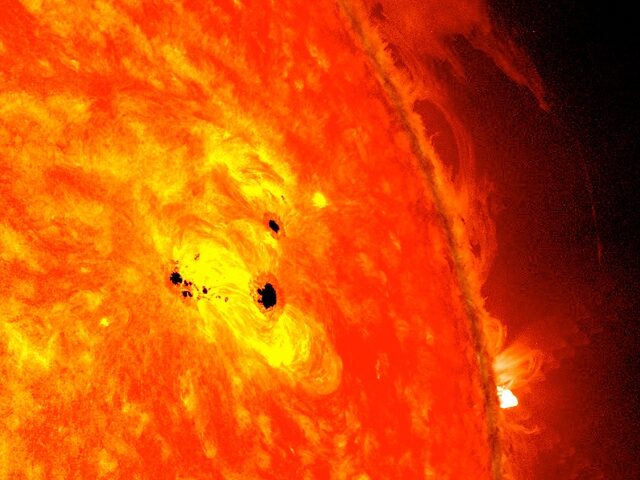NASA scientists have recorded a large cluster of sunspots on the surface of the sun while issuing a warning to those who want to view it.
Fox News reported Saturday there was also risk for solar flares that can affect things such as spacecrafts, radio communications, electric power grids, and navigation signals.
“Real-time images from NASA’s Solar Dynamics Observatory show an enormous sunspot group moving across the Sun right now! If you have eclipse glasses and good vision, you might be able to see it without magnification. (Never look directly at the Sun without proper eye protection!)” NASA told people in a social media post on Friday afternoon.
Video footage shows the sun rotating slowly until the sunspots, which look like a cluster of islands, appear:
Real-time images from NASA’s Solar Dynamics Observatory show an enormous sunspot group moving across the Sun right now!
If you have eclipse glasses and good vision, you might be able to see it without magnification. (Never look directly at the Sun without proper eye protection!) pic.twitter.com/5clNZg6WKe
— NASA Sun & Space (@NASASun) February 9, 2024
The Fox article noted that a massive solar flare occurred in December that caused issues with airplane radio communications as it sent radiation toward our planet.
“Magnetic fields for sunspots are thousands of times more powerful than Earth’s,” the article said, adding, “The space agency first discovered the grouping at the end of last month from NASA’s Perseverance rover on Mars and the cluster is now facing Earth.”
According to the NASA Science Space Place website, sunspots appear dark because they are cooler than other areas on the sun.
However, “The temperature of a sunspot is still very hot though—around 6,500 degrees Fahrenheit!” the page read.
“Why are sunspots relatively cool? It’s because they form at areas where magnetic fields are particularly strong. These magnetic fields are so strong that they keep some of the heat within the Sun from reaching the surface,” it noted.
Video footage from 2017 shows another sunspot rotating to face Earth:
In regard to solar flares, NASA said:
The magnetic field lines near sunspots often tangle, cross, and reorganize. This can cause a sudden explosion of energy called a solar flare. Solar flares release a lot of radiation into space. If a solar flare is very intense, the radiation it releases can interfere with our radio communications here on Earth.
“Solar flares are sometimes accompanied by a coronal mass ejection (CME for short). CMEs are huge bubbles of radiation and particles from the Sun. They explode into space at very high speed when the Sun’s magnetic field lines suddenly reorganize,” the website stated.

COMMENTS
Please let us know if you're having issues with commenting.